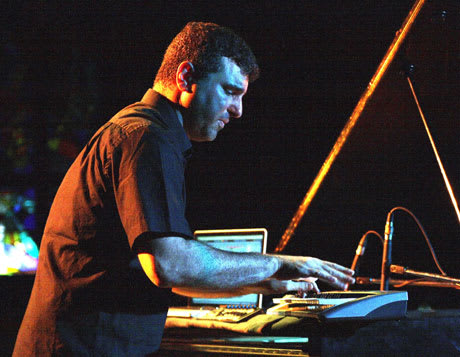As the last performance of this year's X Avant festival, John Kameel Farah took some time to explain to the audience the background of the work he was about to perform. The theme of the night was hybrid music forms incorporating Arabic influences with electronics, and Farah's performance followed an opening laptop set by Matthew Miller, transforming Moroccan and North African field recordings.
Starting off on the piano, a few minutes in Farah reached for his controller hooked up to a laptop placed atop the piano and a distant drone began to emanate from the speakers. When the rhythm track picked up, it had a real drum 'n' bass flavour, to it which was a surprisingly successful marriage with the baroque piano parts being played. The impressive thing was that the electronic portion of the music didn't feel at all tacked on or layered underneath the piano, but an integral part of the composition.
Farah explained that for the second piece he was playing a synth because it contained quarter tones, which obviously can't be played on a piano, and because he simply loves synthesizers. The track began as a solo synth piece full of Arabic influence but, after switching to piano, was accompanied by a frenetic backing rhythm that he played along with.
At one point, Farah played a piece that he revealed he had just composed the day before. The piano sounded amazing in the space, and again it was educational to hear how the electronics and piano melded together as almost qanun-like sounds built into an aggressive war-like rhythm.
After a solo piano fugue — the second of the night, this time inspired by Renaissance-era English composer William Byrd — Farah played "Distances" from his latest EP as his final piece, with its circular pulse inspired partly by the sheer distances between planets.
It was a joy to see Farah play, putting so much passion into his performance, and although it was a unique set from a talented and innovative musician, it was one that hung together rather awkwardly, shifting from piano fugues to more experimental pieces. Taken individually, the pieces were great, but Farah could benefit from working the arc of his set into something more cohesive. The verbal explanations and context he provided were still illuminating, giving context for the pieces selected.
Starting off on the piano, a few minutes in Farah reached for his controller hooked up to a laptop placed atop the piano and a distant drone began to emanate from the speakers. When the rhythm track picked up, it had a real drum 'n' bass flavour, to it which was a surprisingly successful marriage with the baroque piano parts being played. The impressive thing was that the electronic portion of the music didn't feel at all tacked on or layered underneath the piano, but an integral part of the composition.
Farah explained that for the second piece he was playing a synth because it contained quarter tones, which obviously can't be played on a piano, and because he simply loves synthesizers. The track began as a solo synth piece full of Arabic influence but, after switching to piano, was accompanied by a frenetic backing rhythm that he played along with.
At one point, Farah played a piece that he revealed he had just composed the day before. The piano sounded amazing in the space, and again it was educational to hear how the electronics and piano melded together as almost qanun-like sounds built into an aggressive war-like rhythm.
After a solo piano fugue — the second of the night, this time inspired by Renaissance-era English composer William Byrd — Farah played "Distances" from his latest EP as his final piece, with its circular pulse inspired partly by the sheer distances between planets.
It was a joy to see Farah play, putting so much passion into his performance, and although it was a unique set from a talented and innovative musician, it was one that hung together rather awkwardly, shifting from piano fugues to more experimental pieces. Taken individually, the pieces were great, but Farah could benefit from working the arc of his set into something more cohesive. The verbal explanations and context he provided were still illuminating, giving context for the pieces selected.
